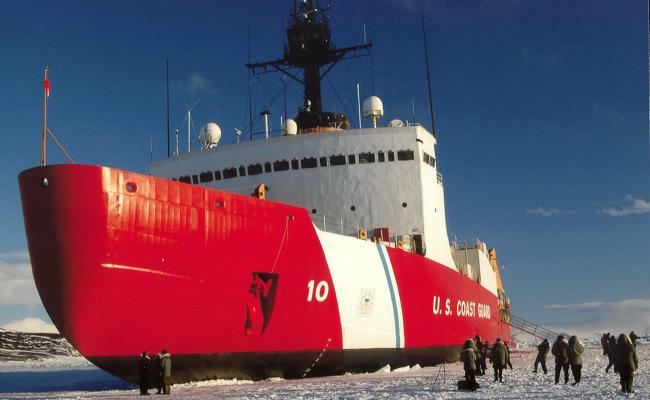Trump, Congress Earmark 675 Million USD for Icebreaker Program in Major Move

The Coast Guard Cutter Healy (WAGB-20), a polar-class icebreaker, transits Southeast Alaskan waters, November 24, 2018.
US gets serious about funding a new Arctic icebreaker.
Over 40 years after the last heavy-duty American icebreaker was commissioned, the US government took its most serious action to date towards building a replacement vessel on 15 February when President Trump signed the FY2019 Department of Homeland Security funding bill.
A step change in funding
In addition to averting a second consecutive government shutdown, the bill - passed by both the House and Senate and signed into law on 15 February - appropriates 675 million USD for the US Coast Guard’s Polar Security Cutter (PSC) program, by far the largest sum allocated to the project to date.
The 675 million USD figure is nearly double the 360 million USD allocated to the PSC program in the previous five years combined.

Previous icebreaker funding.
Significantly, all 675 million USD is allocated to the Coast Guard’s own acquisition budget, rather than borrowing from the US Navy’s much larger shipbuilding account, as Congress did in the previous two budgets.
As telling is how the icebreaker program fits in alongside the Coast Guard’s various other acquisition needs.
In a budget year when Coast Guard leadership has stated that "recapitalization and continued investment in our Service’s future is a top budget priority in FY2019," the service’s single largest acquisition program approved by Congress this year is the icebreaker program - larger than all other vessel and aircraft construction programs the Coast Guard wanted this year.

USCG 2019 acquisition budget.
Not Just One New Vessel
Of the sizable 675 million USD funneled to the PSC program, Congress specified that 655 million USD be earmarked for the construction costs of the first icebreaker in what the Coast Guard envisions as a class of 3 heavy polar icebreakers.
Combined with the 360 million USD allocated to the PSC program in previous years, the Coast Guard has secured enough funding to construct the lead vessel, which is estimated to cost between 700 million USD and 1 billion USD.
Prior to this year, Congress had only allocated funds to the lead icebreaker. However, included in this year’s Congressional funding guidance is 20 million USD devoted specifically to a second icebreaker - a vessel that Coast Guard leadership has planned for in recent years but did not officially request funds for in this year’s budget.
The 20 million USD is earmarked to purchase what are known as long leadtime materials (LLTM) for the second vessel.
The additional funding marks not only the first time Congress has authorized funds for another icebreaker beyond the lead vessel in the class, but it also represents an acceleration of the acquisition timetable for the second vessel compared to what was originally laid out by the Coast Guard in 2016.
Funding was no sure thing
Despite the size of the 675 million USD allocation compared to previous years, the figure is still shy of the 750 million USD the Coast Guard asked for in President Trump’s original FY2019 budget request. Nonetheless, Coast Guard leaders will likely be pleased with the final allocation given the contentious nature of this year’s budget negotiations.
Just last month the Coast Guard’s prospects of receiving any funding for the PSC program looked uncertain at best.
Given that the Coast Guard is housed under the Department of Homeland Security alongside agencies like Customs & Border Patrol (CBP) and Immigration and Customs Enforcement (ICE), money for the icebreaker program looked like it would fall victim to negotiations between Congress and the White House over funding for a southern border wall.
Some drafts of House appropriations bills went so far as to strip all funding for the PSC program.
Even before the government shutdown, Commandant of the United States Coast Guard Adm. Karl L. Schultz, stated that he was only "guardedly optimistic [that] funding for that first polar security cutter is going to be there."
Also read
Finally, the 650 million USD is in some respects far more than the Coast Guard was expecting to devote to the PSC program this year.
As late as this past spring, the Coast Guard envisioned a much smaller budget for the icebreaker program and the 750 million USD the Coast Guard eventually requested was a relatively last-minute addition - early drafts of the White House’s budget requests showed only a 30 million USD figure for the PSC program in FY2019.
Challenges remain
While the newly signed FY2019 budget adds serious momentum to the Coast Guard’s polar icebreaker acquisition efforts, the PSC program still faces challenges ahead.
Aside from selecting a shipyard to construct the lead vessel, one of the biggest questions facing the program is whether the Coast Guard’s ambitious delivery timetable can be met.
Although the Coast Guard received the majority of the 750 million USD it requested from Congress, questions still remain whether the the lead vessel will be delivered by late 2023, which the service has maintained is its goal.
The Coast Guard originally laid out its delivery goal in a 2016 Request for Information (RFI), in which it stated the lead icebreaker of the class would be delivered in late 2023—despite no US shipyard building a heavy icebreaker for over 40 years. The service has continued to stick by that target ever since.
However, a recent September 2018 Government Accountability Office (GAO) report called into question that timeline, assessing that it was overly ambitious even with full funding.
For the first time, full funding has been secured for the first lead icebreaker of the class. It will now be up to Coast Guard administrators—and the shipyard chosen to build to vessel—to reach the ambitious delivery goal. In the meantime, the 43-year-old Polar Star will continue to age and continue to remain the nation’s sole heavy icebreaker.


